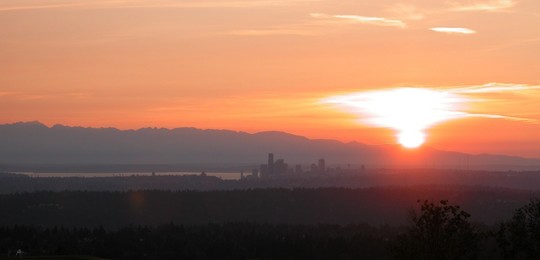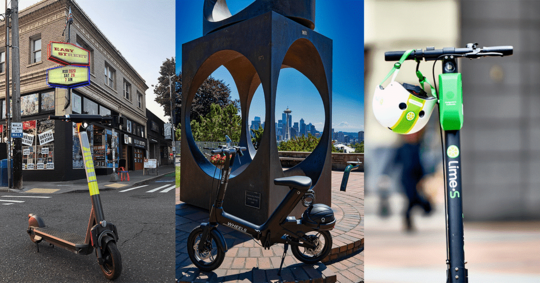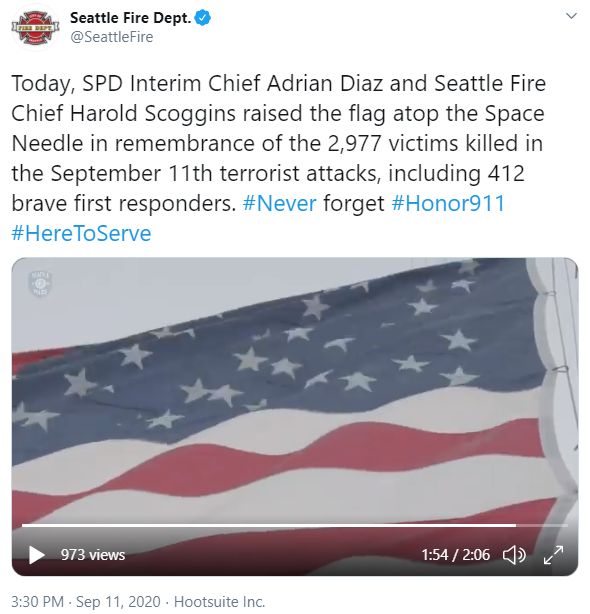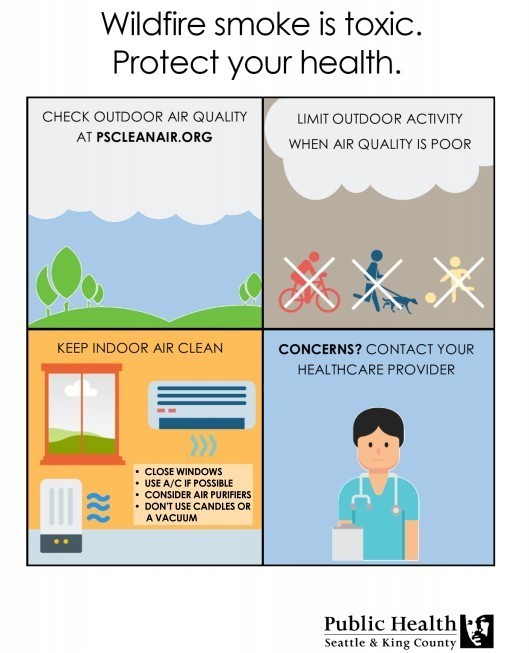 2020 has truly been a year of challenges for all of us.
Right now, Seattle is facing a new challenge: one of the worst air qualities in the world. After seeing some unhealthy levels of wildfire smoke for a short time period earlier this week, our region is experiencing hazardous levels of produced by the wildfires in Oregon and California, which are expected to last for the next several days.
This forecast impacts all of us, and it will undoubtedly exacerbate existing harms caused by the COVID-19 pandemic. In recent days, the County Executive, Public Health ? Seattle & King County Director Patty Hayes, Health Officer Dr. Jeff Duchin and I have all been in discussions regarding how to prepare for unhealthy air quality in the midst of a pandemic.
We know that indoor gathering ? even with the proper precautions ? increases a person?s likelihood of catching or spreading the virus. However, the threat of unhealthy air quality has become so great that we are taking additional actions as a City, including closing our parks and standing up an additional emergency shelter for people experiencing homelessness.
Traditionally, the region?s smoke and unhealthy air quality response has relied on people minimizing time outdoors and informing people of available facilities that have air filtration. Public Health ? Seattle & King County advises that facilities should meet air filtration guidance and guidance from the Centers for Disease Control & Prevention to reduce risk of COVID-19 transmission including social distancing and other health and hygiene measures.
King County Executive Dow Constantine and I announced the opening of a new healthy air center in SoDo for people experiencing homelessness during the wildfire smoke this weekend. The SoDo site will open this afternoon and will provide approximately 80 people with healthy air and shelter. ?Beginning today and through the weekend, the City?s parks, boat ramps, beaches, playfields, and library curbside pickup locations will be closed.
Public Health ? Seattle & King County advises all those who are able to stay inside for the duration of the unhealthy air quality. All those who have asthma or other respiratory conditions should take care to have their inhaler and other relevant medications. If a person with existing health conditions experiences a worsening of their condition due to the unhealthy air, they should contact their health care provider immediately.
It?s important to note that cloth face coverings ? while critical to preventing the spread of COVID-19 ? do NOT prevent respiratory harms that could be caused by unhealthy air quality. N95 and N100 masks offer slightly better protection against unhealthy air quality, however, those should continue to be reserved for health care workers and first responders addressing the COVID-19 pandemic.
I encourage you to regularly check Puget Sound Clean Air Agency for updates on air quality. For information about COVID-19, including in multiple languages, visit www.kingcounty.gov/COVID
The Seattle Fire Department urges the public to take steps to prevent additional fires from starting, to include properly discarding of smoking materials and ensuring vehicles don?t create sparks. Read more on the Fireline Blog.
I know these times are incredibly tough for individuals, families, and small businesses in Seattle. As we move forward, I will continue to do everything possible to get the region the resources we need to get through this pandemic.
As always, please continue to write me at [email protected], reach out via Twitter and Facebook, and stay up-to-date on the work we?re doing for the people of Seattle on my blog.
Please stay safe and healthy this weekend.
 
On Wednesday, Mayor Durkan today announced up to $11.6 million in funding for shelter, day-centers, and permanent supportive housing to assist our City?s service providers during COVID-19. To date, these efforts have resulted in new enhanced shelter capacity, the opening of temporary spaces to de-intensify large congregate shelters, the ongoing operation of day-centers, and support to emergency shelters and permanent supportive housing to meet public health requirements. These program modifications have minimized shelter space loss during the pandemic.
As noted by the National Health Care for the Homeless Council, ?Seattle has had one of the most progressive responses to COVID-19 for people living homeless? by making more room in shelters, deploying additional hand-washing stations, and some mobile showers. These efforts have helped homeless service programs to operate safely and without the large-scale spread of COVID-19 like many outbreaks seen in other cities. Throughout the City of Seattle homelessness response network, the City?s efforts have resulted in a positivity rate that is consistent with the rate of positive tests across the general population.

Seattle?s Office of Planning and Community Development (OPCD) recently outlined priorities to study during the next iteration of the City?s foundational city plan, the Seattle 2035 Comprehensive Plan.
In testimony before the City Council this week, OPCD outlined Mayor Jenny A. Durkan?s vision for planning a reimagined and more equitable City which addresses the systemic issues brought to light during the COVID-19 pandemic, economic collapse and civil rights reckoning. Mayor Durkan proposed new station-area planning around the future 130th St. Sound Transit light rail station, strengthening the City?s industrial maritime jobs, committing to a racially equitable recovery from the global pandemic, and exploring the concept of ?15-minute neighborhoods? which could include additional affordable housing near Parks facilities.
In addition to the presentation before the Seattle City Council?s Land Use and Neighborhoods committee, OPCD sent a memo that outlines the Administration?s ongoing work on transit-oriented housing, walkable amenities for every neighborhood, and equitable access to job opportunities in the maritime industrial economy.?

The City?s Office of the Waterfront and Civic Projects will begin removal of Pier 58 this weekend. Engineers have observed increasing movement and deterioration of the pier structure and continue to monitor the pier closely. Due to the accelerated deterioration of the pier, the contractor is advancing critical work over the weekend, using appropriate protocols given the current smoke emergency. ?
Removal of the pier is largely done waterside from a barge that arrived on September 4. The City will remove as much of the pier deck, piles and structures as necessary to ensure site safety. We will continue construction seven days a week, during daylight hours, until further notice. Pier 58 removal is expected to be completed by early 2021.
Pedestrian access to all businesses will be maintained throughout pier removal. Pier 58 is located between the Seattle Aquarium and Pier 57 (Miner?s Landing).
The City has planned for years to remove the existing Pier 58 and replace it with a new public park pier including a playground, public plaza and landscaping. To learn more about construction and pier park design, visit waterfrontseattle.org.

 Following a careful review process, Seattle DOT has invited three potential scooter companies? (Lime, Wheels, and LINK) to seek permits.
This is one of the final steps towards launching the new Scooter Share Program authorized by Seattle City Council earlier this week, and is the culmination of months of planning and coordination to create a safe, equitable, and accessible scooter share program based on ongoing conversations with the community, stakeholders, and public safety experts.
We expect that people may be able to start renting scooters in Seattle sometime in the very near future, depending on how quickly these companies are able to complete their permit paperwork, hire local staff, and get their fleet of scooters ready.

 This morning, on the 19th anniversary of September 11th, Fire Chief Harold Scoggins and Interim Police Chief Adrian Diaz raised the American flag atop the Space Needle in recognition and remembrance of all the lives lost on the attack against the Twin Towers on 9/11/2001 in New York City. We encourage you to check out the tribute video on the Seattle Fire Department?s Twitter account.
Watch now

 As wildfires rage across the entire west coast, a giant wave of smoke has blown across Western Washington, creating worsening air quality that will likely linger for days. The air quality across Washington has the potential to reach extremely unhealthy levels, and the Washington State Department of Health wants people to be prepared. It?s not just the smoke, either: with COVID-19 as an ongoing factor, people need to know how to stay safe from smoke and fire while preventing the spread of disease.
Breathing in wildfire smoke can cause symptoms that are relatively minor, such as eye, nose, and throat irritation, and also more dangerous symptoms like wheezing, coughing, and shortness of breath. The best way to protect yourself from smoky air is to stay inside and keep your indoor air clean by improving filtration ?and creating a clean air room in your home. To reduce the intake of smoke into your home:
This wildfire season is especially challenging during the COVID-19 pandemic. If you?re considering leaving the area to escape smoke or fire, consider the COVID-19 restrictions in the county you are traveling to, and the people you are visiting. This is especially important if they are at high risk for severe COVID-19. For those taking in people trying to escape fire or smoky conditions: please keep your circles small, wear masks indoors, and continue washing your hands often.
Please stay tuned to the local media in your area to learn updates about smoke and fire activity near you. To read more about the wildfires in our state, please check out the Washington Smoke Information blog for regular updates. For more information on protecting yourself and your loved ones during wildfire smoke events, visit our Smoke From Fires home page.
The DOH website is your source for a healthy dose of information. Find us on Facebook and follow us on Twitter. Sign up for the DOH blog, Public Health Connection.

|